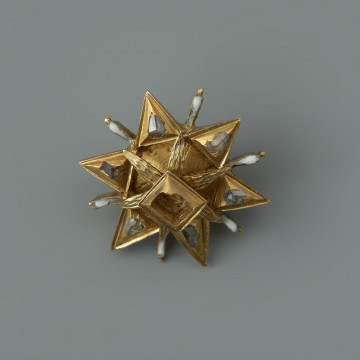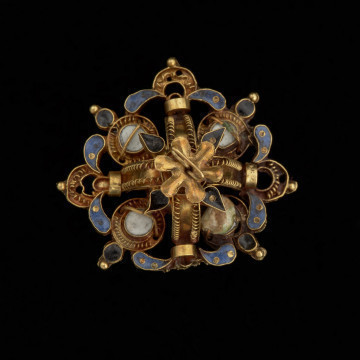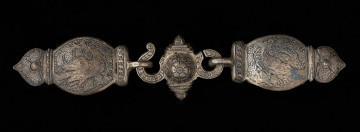
Star-shaped dress jewellery
nie po 1637
National Museum in Szczecin
Part of the collection: Antiquity
The burial ground in Lubowidz (German. Luggeweise) in the Lębork district, was discovered by accident in 1898 during the operation of a gravel pit there. The monuments found in the following years were systematically inventoried by Eduard Stielow (active ca. 1925-1946), the district relic supervisor. Materials discovered in 1898, 1926 1932, 1934 and 1938 were transferred to the Pommersches Landesmuseum in Szczecin (1927-1945) and the Westpreussisches Provinzial-Museum in Danzig (1880-1945), some of which were published in the "Heimatkalender für den Kreis Lauenburg in Pommern". The excavations were carried out between 1938 and 1939 by Helmut Agde (1909-1940) on behalf of the Pommersches Landesmuseum in Szczecin. He managed to excavate 308 graves in the exposed 75 acres of the site, of which 241 were inhumed and 60 were cremated. A detailed study of the site and the movable artefacts discovered there was made by Ryszard Wołągiewicz (1933-1994) from the National Museum in Szczecin, in a monograph published in 1995. The fibula on display, dated to the Roman influence period, i.e. the end of the 2nd century AD, comes from grave no. 71, where two other bronze clasps of a different construction but similar gold ornamentation, a belt buckle and two bronze sigmoid buckles, a necklace of 35 amber and glass beads, a silver biconial bead, a clay spinner and two small ceramic vessels were also found.The clasp cast in bronze was given its final form by forging. The flat bail and the comb above the hood covering the spring were then covered with appliqués with a repousse ornament of small waves and zigzags on the cap. The design of the clasp in the form of a comb over a spring is characteristic of the entire group of fibula, according to some researchers, modelled on examples in fashion in the northern European Roman provinces. Bartłomiej Rogalski
Author / creator
Object type
fibula
Technique
casting, forging, repoussage
Material
bronze, gold
Origin / acquisition method
danwe zbiory muzeum
Creation time / dating
Creation / finding place
Owner
Muzeum Narodowe w Szczecinie
Identification number
Location / status

nie po 1637
National Museum in Szczecin

nie po 1637
National Museum in Szczecin

około 1600
National Museum in Szczecin
DISCOVER this TOPIC
Museum of King Jan III's Palace at Wilanów
DISCOVER this PATH
Educational path